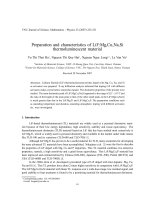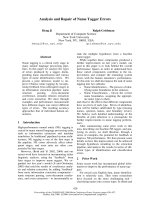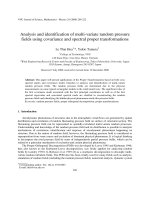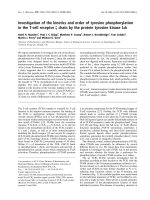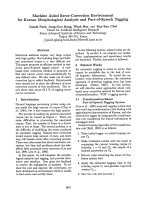Waste analysis and characteristics of solid waste in pila laguna
Bạn đang xem bản rút gọn của tài liệu. Xem và tải ngay bản đầy đủ của tài liệu tại đây (868.59 KB, 51 trang )
THAI NGUYEN UNIVERSITY
UNIVERSITY OF AGRICULTURE AND FORESTRY
JUAN MIGUEL D. AMARA
WASTE ANALYSIS AND CHARACTERISTICS OF SOLID WASTE IN
PILA, LAGUNA PHILIPPINES
BACHELOR THESIS
Study Mode :
Major
:
Faculty
:
Batch
:
Full-time
Environmental Science and Management
International Programs Center
2013 - 2017
Thai Nguyen, 2017
Thai Nguyen University of Agriculture and Forestry
Degree Program
Bachelor of Environmental Science and Management
Student Name
Juan Miguel D. Amara
Student ID
DTN1454290050
Thesis Title
WASTE ANALYSIS AND CHARACTERISTICS OF SOLID
WASTE IN PILA, LAGUNA
Supervisor(s)
Dr. Rico C. Ancog of University of the Philippines Los Baños
Dr. Do Luan of Thai Nguyen University
Abstract:
The study indicates the aspect of assessing land use and solid waste disposal in the
development of strategies to improve the economy of a small but growing local
government unit like Pila, Laguna. This method was derived from the systems analysis
method employed by environmental scientist in the assessment of policies projects and any
undertaking that are nature and environment based. This approach is a digression from the
traditional method of commodity-based approaches that looks only into a particular area in
assessment. For example, providing discounts in tax and permits to an investor that
considers only monetary incentive aspects in the design maybe profitably stable but may
not guarantee success particularly if it failed to obtain social and environmental
acceptability.
Taking into consideration the physical and socio-economic aspects of the
environment, the study was able to identify specific concerns and develop the
corresponding strategies that were relevant to the improvement of the LGU’s economy
through sound solid waste management program. The methods as well as the information
generated from this study can be important inputs not only for the land use plan and design
of the solid waste management program but more importantly in enhancing the technical
capability of the personnel and staff of the agency involved in the economic improvement.
Lastly, this study showed the concerned agencies the importance of integrating
social considerations in the comprehensive land use plan and the design and management
of sanitary landfill facility as the final disposal. The study can serve as a reference
document to stakeholders for economic assessment on waste analysis and characteristics of
solid waste management in Pila, Laguna.
Keywords
waste analysis/characteristics of solid waste
Number of Pages
Forty-three (43) pages
Date of submission
November 2017
Signature of the
Supervisor
ACKNOWLEDGEMENT
“With God, nothing is impossible”
This humble piece of work of a simple but striving hard student like me wouldn’t be
possible without the assistance of these extra ordinary beings that pushed me to the
limits of my ability to complete this research study:
Our dearest Lord God
Who, in His appointed time and circumstances, made this research study possible;
Thai Nguyen University of Agriculture and Forestry
For implementing this academic requirement and for showing us its great interest in
improving our capabilities
Our Teachers, Critics and Advisers
For linking us to different venues which could possibly help us and for assisting us in all
our needs and concerns. Thank you for making us feel that we are very capable and for
letting us feel that you are just around should anything arise;
My Family
My dad (Pablo) for financing my needs, my mom (Nelia) for excusing me from house
works and my two younger brothers (Paolo and Kevin) for teaching and helping me to
do this thesis. Thank you for the support and for sharing precious times with me;
My Classmates
Thank you for the good vibes everyday;
And for all others whose names and contributions slipped from my memory at this
moment - Thank you.
TABLE OF CONTENT
List of Figures …………………………………………………………….. 1
List of Tables ……………………………………………………………… 2
List of Abbreviations ……………………………………………………… 3
PART I. INTRODUCTION……………………………………………….. 4
Research rationale …………………………………………………………. 4
Research objectives ……………………………………………………….. 7
Research questions and hypothesis ……………………………………….. 8
Limitations ………………………………………………………………… 8
Definitions ………………………………………………………………… 9
PART II. LITERATURE REVIEW ……………………………………… 10
PART III. MATERIALS AND METHODOLOGY ……………………… 19
PART IV. RESULTS, DISCUSSION AND CONCLUSION ……………
32
4.1.
Results ……………………………………………………………… 32
4.2.
Discussion …………………………………………………………. 35
4.3.
Conclusion …………………………………………………………. 41
REFERENCES ……………………………………………………………. 43
APPENDICES ……………………………………………………………. 44
LIST OF FIGURES
Figure 1. Weighing scale
Figure 2. Calibrated pail
Figure 3. Sources and Final Disposal of Wastes according to classification
Figure 4. Characterizing of Municipal Solid Waste
Figure 5. Waste Source Categories
Figure 6. Data Sampling
Figure 7. Largest waste producers in the municipality
Figure 8. Contributor of Mixed Wastes in the municipality
Figure 9. Waste composition percentage
Figure 10. Percentage of residual waste
1
LIST OF TABLES
Table 1. Summary Showing the Quantity and Composition of Waste Disposed,
Residential
Table 2. Projected Waste Generation
Table 3. Recommended program options for Waste collected in Pila
2
LIST OF ABBREVIATIONS
EcoGov – Environmental Governance Project of the Philippines
CLUP – Comprehensive Land Use Plan
LGU – Local Government Unit
MRF – Materials Recovery Facility
SWM – Solid Waste Management (SWM)
SWMB – Solid Waste Management Board
SWMP – Solid Waste Management Plan
WACS – Waste Analysis and Characterization Study
3
PART 1. INTRODUCTION
1.1.
Research rationale
Lands in the Municipality of Pila have been declared as alienable and
disposable. Based on current use and purpose, these lands are classified into
agricultural
(83.80%),
residential
(7.33%),
parks/playgrounds/recreational
space/special use area (2.23%), institutional (1.94%), infrastructures/utilities
(1.34%), agro-industrial (.80%), commercial (.38%) and other uses (2.18%). The
total land area of Pila under its territorial jurisdiction is 3.120 hectares.
From being a fourth class municipality in terms of economic
classification, the Municipality of Pila was recently alleviated to third class. This
means that during the past three years, the municipality has shown remarkable
growth and improvement in its economic activity. Concentrations of commercial
development in Pila are found in the poblacion. Business establishments being
mostly market-oriented have the tendency to get located in areas accessible to
residential concentrations. Hence, ribbon-type growth has been the dominant trait
of commercial development in the locality. They are mainly along the national
road where most of Pila's 554 registered business establishments are located.
Land uses for industrial purposes are not too distinct compared to
commercial development. There are few industries mostly small or cottage level
of operation which is household-based hence locations and sites are mixed along
commercial and residential area. The agricultural industries however, such as the
commercial poultry producers and piggeries, have their places utilizing existing
agricultural lands in their operation in various barangays both rural and urban.
4
Commercial poultry operators have indicated some pressure related to land use
problem. Although the need for designated areas for the agro-industry sector has
yet to be resolved, the potential of agro-industrial growth in Pila remain strong as
it enjoys the continued confidence of existing investors. There are also clear
potential for more integration of these types of industries with the existing
primary production activities in Pila that can result to synergy in employment
creation and faster economic development in Pila. Despite concern for an
environment-friendly direction for the economy, the agro-development sector can
be expected to meet standards and regulations with the continuing advancement
of production technologies and pollution abatement measures and other wastemanagement procedures.
But Pila is foremost agricultural in nature. More than 50% of its
population is somehow dependent on agriculture, particularly farming and
fishing. Pila as an agricultural municipality has attracted quite a number of
seasonal farm workers over the past years. Palay (Rice) production in Pila is still
practiced in a highly labor intensive manner. Shortage of labor during planting
and harvesting season allowed the migration of workers from other regions.
These seasonal workers became permanent members of Pila community.
Regrettably, economic opportunities are not at all abundant to enable them to
earn a living and meet basic need especially housing. This caused the start of the
growth of informal settlers in Pila. Some programs have been started by Pila in
the past to address the informal settler’s problems like allocating relocation sites.
To date, the population of Pila is 50,289. Direct evidences of residential
development trend are reflected in the establishments of residential subdivisions
5
that occurred in early 2002 to present. A total of 21 subdivisions have been
developed in Pila in 2002. In 2007, there were already 26 subdivisions. The
development of subdivisions tends to deviate from ribbon-like and clustering
type of residential development. They were undertaken in leap-frogging fashion
thru converting the use of existing agricultural lands for the residential purposes.
With the rapid increase of the Pila's population resulting to the growth of
residential communities, the Local Government Unit (LGU) is able to come up
with the provision for institutional buildings such as municipal hall, schools and
health centers. It has recently provided for its new public market and built a
separate building for the Philippine National Police. The construction of several
covered-courts was provided to the barangays. Adding to the inventory of
institutional areas are those occupied by public and private schools offering
different levels of education (preparatory, elementary, & secondary level), 1
museum, several health centers, churches and chapels. There are urgent
requirements to be able to provide space requirements needed by Pila as it
addressed its improvement of solid waste, improvement of municipal slaughter
house, bus/jeepney terminal and planned potable water supply system.
Unfortunately, the aforementioned economic growth and development as
well as the increase in population lead to the accumulation of waste which the
municipality generates approximately 15 tons per day, computed as .5kg/capita
per day. The accumulation of waste has tremendous impact to the booming
economy of Pila. That is why comprehensive study on the proper regulating solid
waste management is important.
6
1.2.
Research objectives
The objective of this study is to assess the status of Solid Waste
Management (SWM) on households in Pila Laguna Philippines.
The specific objectives are:
1.2.1. To characterize the waste generated in household in terms of volume and
types.
1.2.2. To identify the facts that influences the amount and types of waste
generated.
1.2.3. To identify the waste management practice of the household and asses the
costs and benefits of its implement.
1.2.4. To provide recommendations to enhance solid waste management
programs at the LGU-level in Pila.
1.3.
Research questions and hypothesis
One of the main problem in every developing towns, the increasing
volume of solid waste that is being generated due to high rate of rural-urban
migration, the uncontrolled growth of industries and businesses as well as
changes in the consumption patterns of residents. Combined with lack of
awareness on the environmental effect of improper disposal of solid wastes and
considering the inadequacies in the implementation of policies and program on
solid waste management, finding the appropriate solution remains to be a
challenge to the Municipal Government of Pila.
In this research, the researcher will analyze and characterize the solid
waste materials in the local household. This is essential to have a better
understanding of the average solid waste that usually collected by the waste
7
picker, the solid waste that are collected in every household and characterize all
the recyclable, non-recyclable, and organic solid waste and determine the average
volume of each types of solid waste.
1.3.1.
The study was guided by the following research questions:
1.3.1.1.
What are the types and volume of solid waste generated in household?
1.3.1.2.
What are the factors that affect the amount and types of waste
generated?
1.3.1.3.
What waste management practice in household and its cost and
benefit in the implement?
1.3.1.4.
What are the recommendations that can be provide to enhance the
existing solid waste plan?
1.3.2.
The hypotheses of the study are the following:
1.3.2.1
The volume of recyclable solid waste is different to each level of
lifestyle.
1.3.2.2
The volume of recyclable solid waste is almost the same to each level
of lifestyle.
1.4
Limitations
The study focused on the existing economic profile, municipal
comprehensive land use plan focused on soil and environment as well as solid
waste management practices in Pila, Laguna. Due to the limited time of data
collection, the study validated data on a random basis through site visitation and
interviews.
8
1.5
Definitions
1.5.1. The Municipal Government of Pila is a Local Government Unit
equivalent to a town managed by elected government officials headed by a
Mayor for the executive functions and for the legislative functions – the
Vice Mayor and Councilors.
1.5.2. The Comprehensive Land Use Plan (CLUP) is a document designed to
guide the future actions of a community. It presents a vision for the future,
with long-range goals and objectives for all activities that affect the local
government.
1.5.3. Solid
Waste
Management
refers
to
the
supervised
handling
of waste material from generation at the source through the recovery
processes to disposal.
1.5.4. Barangay formerly referred to as barrio, is the smallest administrative
division in the Philippines and is the native Filipino term for a village,
district or ward.
1.5.5. EcoGov refers to the Philippines Environmental Governance Phase 2
Project (EcoGov) which is an initiative of the Government of the
Philippines, implemented in partnership with the Department of
Environment and Natural Resources, Department of the Interior and Local
Government, local government and other stakeholders.
9
PART II. LITERATURE REVIEW
2.1 What is Solid Waste Management?
Solid waste management is a term that is used to refer to the process of
collecting and treating solid wastes. It also offers solutions for recycling items
that do not belong to garbage or trash. As long as people have been living in
settlements and residential areas, garbage or solid waste has been an issue. Waste
management is all about how solid waste can be changed and used as a valuable
resource. Solid waste management should be embraced by each and every
household including the business owners across the world. Industrialization has
brought a lot of good things and bad things as well. One of the negative effects of
industrialization is the creation of solid waste.
2.1.1. Various Sources of Solid Waste
Tons of solid waste is disposed of at various landfill sites each day. This
waste comes from homes, offices, industries and various other agricultural
related activities. These landfill sites produce foul smell if waste is not stored and
treated properly. It can pollute the surrounding air and can seriously affect the
health of humans, wildlife and our environment. The following are major sources
of solid waste:
2.1.1.1.
Residential
Residences and homes where people live are some of the major sources of
solid waste. Garbage from these places include food wastes, plastics,
paper, glass, leather, cardboard, metals, yard wastes, ashes and special
wastes like bulky household items like electronics, tires, batteries, old
10
mattresses and used oil. Most homes have garbage bins where they can
throw away their solid wastes in and later the bin is emptied by a garbage
collecting firm or person for treatment.
2.1.1.2.
Industrial
Industries are known to be one of the biggest contributors of solid waste.
They include light and heavy manufacturing industries, construction sites,
fabrication plants, canning plants, power and chemical plants. These
industries produce solid waste in form of housekeeping wastes, food
wastes, packaging wastes, ashes, construction and demolition materials,
special wastes, medical wastes as well as other hazardous wastes.
2.1.1.3.
Commercial
Commercial facilities and buildings are yet another source of solid waste
today. Commercial buildings and facilities in this case refer to hotels,
markets, restaurants, go downs, stores and office buildings. Some of the
solid wastes generated from these places include plastics, food wastes,
metals, paper, glass, wood, cardboard materials, special wastes and other
hazardous wastes.
2.1.1.4.
Institutional
The institutional centers like schools, colleges, prisons, military barracks
and other government centers also produce solid waste. Some of the
common solid wastes obtained from these places include glass, rubber
waste, plastics, food wastes, wood, paper, metals, cardboard materials,
electronics as well as various hazardous wastes.
2.1.1.5.
Construction and Demolition Areas
11
Construction sites and demolition sites also contribute to the solid waste
problem. Construction sites include new construction sites for buildings
and roads, road repair sites, building renovation sites and building
demolition sites. Some of the solid wastes produced in these places
include steel materials, concrete, wood, plastics, rubber, copper wires, dirt
and glass.
2.1.1.6.
Municipal services
The urban centers also contribute immensely to the solid waste crisis in
most countries today. Some of the solid waste brought about by the
municipal services include, street cleaning, wastes from parks and
beaches, wastewater treatment plants, landscaping wastes and wastes from
recreational areas including sludge.
2.1.1.7.
Treatment Plants and Sites
Heavy and light manufacturing plants also produce solid waste. They
include refineries, power plants, processing plants, mineral extraction
plants and chemicals plants. Among the wastes produced by these plants
include, industrial process wastes, unwanted specification products,
plastics, metal parts just to mention but a few.
2.1.1.8.
Agriculture
Crop farms, orchards, dairies, vineyards and feedlots are also sources of
solid wastes. Among the wastes they produce include agricultural wastes,
spoiled food, pesticide containers and other hazardous materials.
2.1.1.9.
Biomedical
12
This refers to hospitals and biomedical equipment and chemical
manufacturing firms. In hospitals there are different types of solid wastes
produced. Some of these solid wastes include syringes, bandages, used
gloves, drugs, paper, plastics, food and chemicals. All these require proper
disposal or else they will cause a huge problem to the environment and the
people in these facilities.
2.2.
Effects of Poor Solid Waste Management
Due to improper waste disposal systems particularly by municipal waste
management teams, wastes heap up and become a problem. People clean their
homes and places of work and litter their surroundings which affects the
environment and the community.
This type of dumping of waste materials forces biodegradable materials to
rot and decompose under improper, unhygienic and uncontrolled conditions.
After a few days of decomposition, a foul smell is produced and it becomes a
breeding ground for different types of disease causing insects as well as
infectious organisms. On top of that, it also spoils the aesthetic value of the area.
Solid wastes from industries are a source of toxic metals, hazardous
wastes, and chemicals. When released to the environment, the solid wastes can
cause biological and physicochemical problems to the environment and may
affect or alter the productivity of the soils in that particular area.
Toxic materials and chemicals may seep into the soil and pollute the
ground water. During the process of collecting solid waste, the hazardous wastes
usually mix with ordinary garbage and other flammable wastes making the
disposal process even harder and risky.
13
When hazardous wastes like pesticides, batteries containing lead, mercury
or zinc, cleaning solvents, radioactive materials, e-waste and plastics are mixed
up with paper and other scraps are burned they produce dioxins and gasses.
These toxic gases have a potential of causing various diseases including cancer.
2.3.
Methods of Solid Waste Management
There are different methods of solid waste management. The following
are some of the recognized methods:
2.3.1.1.
Sanitary Landfill
This is the most popular solid waste disposal method used today. Garbage
is basically spread out in thin layers, compressed and covered with soil or
plastic foam. Modern landfills are designed in such a way that the bottom
of the landfill is covered with an impervious liner which is usually made
of several layers of thick plastic and sand. This liner protects the ground
water from being contaminated because of leaching or percolation. When
the landfill is full, it is covered with layers of sand, clay, top soil and
gravel to prevent seepage of water.
2.3.1.2.
Incineration
This method involves burning of solid wastes at high temperatures until
the wastes are turned into ashes. Incinerators are made in such a way that
they do not give off extreme amounts of heat when burning solid wastes.
This method of solid waste management can be done by individuals,
municipalities and even institutions. The good thing about this method is
the fact that it reduces the volume of waste up to 20 or 30% of the original
volume.
14
2.3.1.3.
Recovery and Recycling
Recycling or recovery of resources is the process of taking useful but
discarded items for next use. Traditionally, these items are processed and
cleaned before they are recycled. The process aims at reducing energy
loss, consumption of new material and reduction of landfills.
2.3.1.4.
Composting
Due to lack of adequate space for landfills, biodegradable yard waste is
allowed to decompose in a medium designed for the purpose. Only
biodegradable waste materials are used in composting. Good quality
environmentally friendly manure is formed from the compost and can be
used for agricultural purposes.
2.3.1.5.
Pyrolysis
This is method of solid waste management whereby solid wastes are
chemically decomposed by heat without presence of oxygen. This usually
occurs under pressure and at temperatures of up to 430 degrees Celsius.
The solid wastes are changed into gasses, solid residue and small
quantities of liquid.
In summary, proper solid waste management is an integral part of
environmental conservation that should be observed by individuals and
companies globally. This will keep the environment clean and reduce health and
settlement problems.
2.4.
Philippines Recent Trends in the Field of Waste Management
15
In 2000, Republic Act 9003 or the Ecological Solid Waste Management
Act was enacted to provide a framework for managing the growing problem of
solid waste in the country. Furthermore, Republic Act 9003 gives prime
importance to the roles of LGUs in managing their respective solid wastes.
2.4.1. Creation of Solid Waste Management Board (SWMB)
2.4.1.1.
Prepares Solid Waste Management Plan (SWMP) as specified
under RA 9003
2.4.1.2.
Monitors the implementation of the SWMP in cooperation with the
private sector and NGOs
2.4.1.3.
Adopts revenue generating measures to promote the viability of
SWMP
2.4.1.4.
Recommends measures for the preservation of the eco system and
safeguards against pollution
2.4.1.5.
Suggests ways, such as franchises or Build-Operate-Transfer
(BOT) agreements, for the collection, transfer, storage, processing,
recycling, or disposal of solid wastes.
In 2004, a total of 103 cities representing 94% of the total 109 had
organized their SWMBs in accordance with the provisions of RA their SWMBs
in accordance with the provisions of RA 9003. Of this number, however, only 49
cities or 44% had effective SWMBs.
2.4.2. Creation of Solid Waste Management Plan (SWMP)
2.4.2.1.
Waste characterization
16
2.4.2.2.
Proper waste collection and transfer
2.4.2.3.
Waste processing
2.4.2.4.
Waste reduction at source
2.4.2.5.
Recycling
2.5.
Source for final waste disposal
In 2004, a total of 91 cities or about 85% of the 107 urban centers
had formulated their respective 10-year SWMPs. Of this number, only 67 cities
had formulated quality SWMPs in accordance with the minimum requirements of
RA 9003. Another 25 cities had demonstrated high performance levels for
formulating quality SWMPs. Furthermore, the remaining 15 cities had within and
below benchmark capacity levels in preparing their respective SWMPs.
2.5.1. Establishment of Materials Recovery Facility(MRF) in Barangay and City
level
2.5.2. Composting of Biodegradable Waste to be used as organic fertilizer
2.5.3. Innovative way of Recycling of Non-biodegradable was t e
2.5.4. Segregation at source Household level
2.5.5. Innovative way of collecting segregated waste using dump trucks,
tricycles and pedicabs
2.5.6. Construction of Sanitary Landfill.
2.6.
Implementation Challenges Encountered
2.6.1. Cannot be effectively addressed by most LGU alone
17
2.6.2. Most do not have enough technical and engineering expertise
2.6.3. Regulatory and enforcement powers with public education, awareness,
and involvement campaigns are not properly implemented
2.6.4. It is not fully implemented, accepted, and institutionalized by the people
and institutions
2.6.5. Doesn’t have strong political will in implementing what is good for the
environment and the people
2.6.6. Only 2% of the Cities of the entire country had established a Sanitary
Landfills due to lack of funds
The biggest challenge to growing LGUs is to come up with solid waste
and pollution control strategies that would effectively reduce the rubbish released
to the environment. Unfortunately, this challenge cannot be effectively addressed
by each LGU alone. LGUs need to combine their technical and engineering
expertise and their regulatory and enforcement powers with public education,
awareness and involvement campaigns to be able to properly implement solid
waste and pollution control programs. Finally, a good solid waste and pollution
control strategy will not be an effective one until it is fully implemented,
accepted, and institutionalized by the people and institutions. As noted by several
local chief executives with exemplary solid waste programs, their strategies were
not about good engineering and slogans but rather strong political will in
implementing what is good for the environment and the people.
18
PART III. MATERIALS AND METHODOLOGY
3.1.
WACS (Waste Analysis and Characterization Study)
Republic Act (RA) 9003, otherwise known as the Ecological Solid Waste
Management Act requires Local Government Units (LGUs) to prepare 10-year
SWM plans. Part of their task is to conduct an activity called the Waste Analysis
and Characterization Study or WACS. Section 17 of the Act defines waste
characterization as “the identification of constituent materials which comprise
solid waste generated and disposed of within an area. It identifies constituent
materials by volume, percentage in weight or its volumetric equivalent, material
type and source of generation which includes residential, commercial, industrial
and institutional.”
The Act further provides the basic method for doing the WACS, the final
result of which is a set of data that shows the per capita and total waste
generation and composition of such waste in a particular LGU. ISWM plans
submitted to the National Solid Waste Management Commission (NSWMC) for
review and approval are expected to include a discussion of the WACS results.
The WACS approach described and illustrated in this manual is the result of
more than five years of work by the Philippine Environmental Governance
Project (EcoGov) and its LGU partners to develop a waste assessment and
characterization process that meets the intent of RA 9003 and is also practical,
replicable and affordable for relatively small LGUs.
19
3.1.1. The key features of the recommended WACS approach are:
3.1.1.1. It has an implementation period of at least three days. The shift from
seven days to a shorter period is supported by a statistical analysis
which showed no significant differences between the seven-day and
three-day WACS data of 49 EcoGov-assisted LGUs (10 cities and 39
municipalities).
3.1.1.2. It looks at both ends of the waste stream – waste generation at source,
and waste at the “end of the pipe” (i.e., the waste that are collected and
brought to the disposal area). The study intends to provide an estimate
of the waste that “leaks out” of the stream or the “unaccounted waste.”
This refers to generated wastes that are uncollected and therefore
disposed in backyards, open spaces, rivers and creeks.
3.1.1.3. LGUs with no waste collection services will focus its WACS on waste
generation at source.
3.1.2. WACS generates these basic data for planning:
3.1.2.1. Waste generation at source (e.g., per unit and total per source)
3.1.2.2. Total waste generation within collection area and in the whole LGU
3.1.2.3. Composition of waste generated at source
3.1.2.4. Volume and composition of waste brought to the disposal site
3.1.2.5. Potential percentage of waste for diversion at source and at disposal site
3.1.2.6. Percentage of generated waste within collection area that is not
accounted for (i.e., wastes not reaching the disposal facility).
3.1.2.7. Waste generation at source is estimated with samples from two types of
waste generators: households and non-households. Non-household
20
